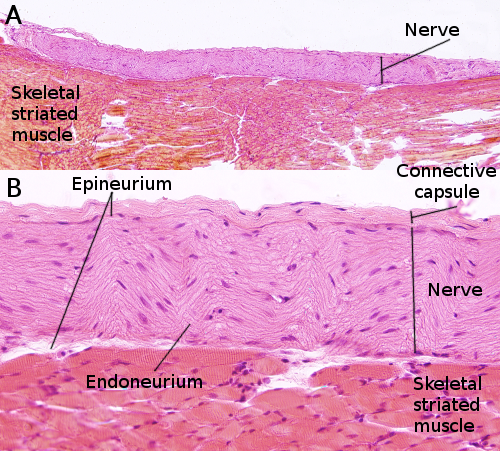Animal organs
Peripheral nervous system
NERVE

Species: rat (Rattus norvegicus. Mammal).
Technique: A) paraffin, Masson thrichrome; B) semithin, toluidin blue; C and D) transmission electron microscopy.
Nerves are bundles of axons located outside the central nervous system (encephalon and spinal cord). Some nerves are quite long like those extending from the spinal cord to the more distal parts of the limbs.
Nerves are made up of axons, Schwann cells (glia) and connective tissue. Axons, also known as nerve fibers, are wrapped by Shwann plasma membrane folds. When they are surrounded by many folds, these folds form layers and all these layers around the nerve fiber are known as myelin, and so it is referred as myelinated axon. If only one fold covers the nerve fiber, even sometimes no fully covered, it is referred as unmyelininated axon.

Nerve fibers, both myelinic and amyelinic, are covered by loose connective tissue known as endoneurium, which fills the space between the nerve fibers. Inside de nerve, groups of axons join together to form fascicles, which are wrapped by connective tissue referred as perineurium. In the same way, the nerve is covered by connective tissue known as epineurium. Large diameter nerves contain blood vessels running among the nerve fibers fascicles.
Nerves can be classified as afferent nerves, when they bring information to the central nervous system, afferent nerves, when information comes from the central nervous system, and mixed nerves, when they carry both afferent and efferent information. They also are classified as cranial nerves, when they enter or leave the encephalon, and spinal nerves when they enter or leave the spinal cord.
